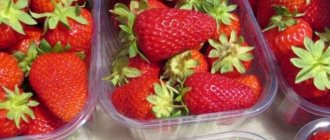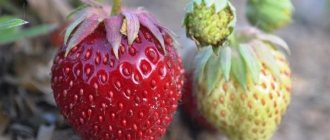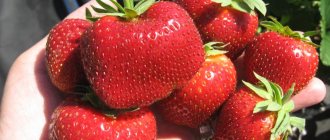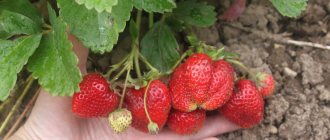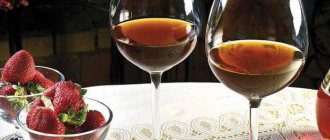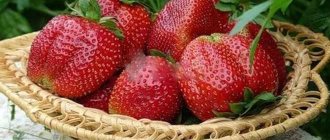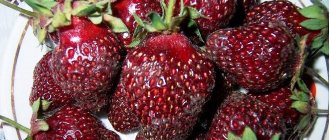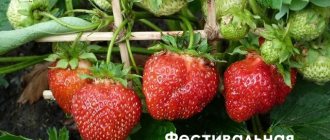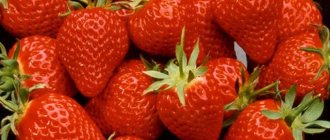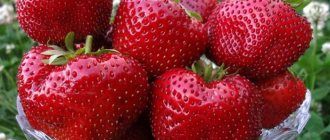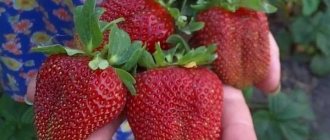Remontant strawberries are increasingly found in the garden beds of amateur gardeners, but not everyone knows about their characteristics and grows them just like regular ones. Today I want to talk about what you should pay attention to when growing remontant strawberries and how they differ from regular strawberries.
If you read the previous article, you know that on my website I still call berries this way: small-fruited berries are strawberries, and large-fruited berries are strawberries. That is, the way everyone is used to separating them, and not the way they are classified in gardening farms (they call these berries garden strawberries, but they are only divided into small-fruited and large-fruited). Further in the text I will write about remontant strawberries, meaning large-fruited remontant garden strawberries.
The agricultural technology for growing remontant strawberries is similar to strawberries, because in fact they are very close relatives. However, remontant strawberries have some features that must be taken into account when growing and caring for them.
You probably know that strawberries (garden strawberries) are divided into regular ones, which bear fruit only once a year, and remontant ones, which can produce 2 or more harvests per season. All this depends on when the plant’s fruit buds can form. Ordinary strawberries form such buds only during short daylight hours (late summer - early autumn). But remontant strawberries can lay flower buds for the next harvest either during long daylight hours (abbreviated as DSD) or during neutral daylight hours (abbreviated as NSD). Accordingly, you may come across terms such as strawberries of the DSD varieties and strawberries of the NSD varieties.
For strawberry lovers, in addition to regular strawberries, I advise you to also have a remontant one with neutral daylight hours in your garden. This will practically eliminate the “berryless” season. And if you also allocate a bed for remontant strawberries, which I wrote about in the last article, then you will generally provide a paradise for strawberry lovers for the entire warm season (right up to frost).
Strawberry Lyubava variety description
Registration for spring pruning has begun!
New entrance to the Nursery from spring 2021
Photo of garden strawberries (strawberries) variety Lyubava
Description of strawberries (garden strawberries) of the Lyubava variety
Very early ripening. The bush is spreading, medium-sized, well-leafed. An average amount of whiskers is formed. The leaves are medium-sized, green, slightly wrinkled, dense, slightly ribbed, concave, glabrous, shiny. The berries are diamond-shaped, red, shiny, with a neck, up to 40 g. The taste of the berries is sweet and sour with an aroma. The pulp is red, juicy, dense, the tasting score of fresh berries is 4.5 points. Winter-hardy, drought resistance is average, heat resistance is high. It was weakly affected by diseases and damaged by pests.
Agricultural technology of garden strawberries (strawberries).
Features of planting and growing.
1. General information about garden strawberries (strawberries). Useful properties of garden strawberries (strawberries).
Strawberries are an excellent preventative against vision impairment and eye defects such as dry eyes, age-related macular degeneration, optic nerve degeneration, and susceptibility to infections. The main cause of all these diseases is free radicals and nutritional deficiencies.
The beneficial substances and antioxidants contained in strawberries saturate the body with essential elements and eliminate the harmful effects of free radicals.
Degeneration of muscle tissue, loss of fluid that affects joint mobility, and toxic substances accumulated in the body lead to arthritis and gout. Strawberries are an excellent detoxifier; they help remove harmful substances from the body and relieve joints of salt deposits.
Vitamin C, anthocyanin, kaemferol, folate, quartzetite are a small part of the flavonoids contained in strawberries that have anti-cancer properties. Including strawberries in the menu slows down the growth of cancer cells and serves as an excellent prevention of oncology.
Thanks to the magnesium and potassium present in this healthy berry, it helps lower blood pressure caused by an excess of harmful salts. Strawberries are especially useful for older people; the berry rejuvenates the body, has a positive effect on brain function, improves memory, stops brain aging and normalizes the functioning of the nervous system.
The presence of iodine in strawberries compensates for its deficiency in the body.
The high content of folate and dietary fiber, the complete absence of fat, and a large set of antioxidants form an ideal complex that affects the overall health of the heart, strengthens the heart muscle, and reduces cholesterol levels in the blood.
The unique medicinal properties of strawberries are used to eliminate intestinal disorders, metabolic disorders, inflammatory processes and even chronic skin diseases. Eating strawberries is indicated for patients with diabetes – it lowers blood sugar levels. Strawberry juice dissolves stones in the bile ducts.
2. Choosing a place for garden strawberries (strawberries).
– Garden strawberries (strawberries) require a well-lit place. Otherwise, the sugar content of the berries may decrease and the overall yield will decrease.
– Garden strawberries (strawberries) should not be planted next to large trees or bushes, and also make sure that there are no crops such as peppers, tomatoes, eggplants or potatoes nearby. These plants can be carriers of verticillium, which is destructive to strawberries.
– Garden strawberries (strawberries) do not tolerate stagnant water. If there is a possibility of flooding of bushes in the area, drainage should be done if possible, and plants should also be planted on hillocks. Otherwise, your strawberries will quickly get wet and, at best, you will end up with bushes sick with gray rot, and at worst, an empty garden bed.
– Garden strawberries (strawberries) require light, slightly acidic soil (pH 5.5-6), medium loamy.
3. Planting garden strawberries (strawberries) and care.
– A garden strawberry (strawberry) seedling should be planted so that the heart remains at soil level.
– Gooseberries do not require mandatory cross-pollination, however, the yield from cross-pollination (the presence of two or more different varieties) increases, the berries become larger and have a better taste.
– The feeding area of one wild strawberry bush is approximately 0.1 sq.m. The distance between two adjacent bushes is 0.3-0.4 meters.
– Garden strawberries should be fed in the spring. When planting, you should add organic fertilizer (horse humus or humus) 5-7 kg/m2, from mineral nutrition you can take 45 grams of superphosphate and potassium salt. You can also apply complex fertilizer such as “Kemira” at a rate of 60-80 g/m2. You can also feed with mullein diluted with 4-5 parts of water, or with complete mineral fertilizer: foscamide, nitrophoska - a tablespoon per 10 liters of water. Feed once every ten days until berries form.
– Watering garden strawberries (strawberries) should be done frequently, but in small quantities (possible in the morning and evening). If there is a lack of moisture during the fruiting period, crop losses may occur.
– Garden strawberries (strawberries) are not the most frost-resistant crop. It is recommended to cover it with covering material, coniferous spruce branches and other materials. The main thing is to open it in time so that the plants do not dry out.
Modern requirements for garden strawberry varieties.
A modern strawberry variety should have the following set of characteristics.
— Powerful, erect, compact or semi-spreading bush, dense or medium foliage.
— The ability to form mustaches with rosettes is moderate.
— Peduncles are numerous, strong, elastic, non-lodging, at or above the level of the leaves.
— Inflorescences are compact, multi-flowered, umbrella-type, raised above the leaves.
— The flowers are bisexual, self-fertile, blooming at the same time.
— The berries ripen at the same time, large (more than 25 g), leveled, symmetrical, conical in shape with a clearly defined neck, smooth, shiny.
— The stalk comes off easily, the calyx is freely separated from the berry.
— The skin of the berries is bright red, evenly colored, dense, the achenes are few in number, slightly embedded in the pulp.
— The pulp is red, juicy, dense, aromatic. The taste is sweet and sour, harmonious.
— High technological qualities of berries, suitability for freezing and all types of processing.
— In addition, varieties must be resistant to diseases and pests, damping off, soaking, freezing, drought-resistant, productive, and have different ripening periods.
Frost-resistant strawberry Lyubava: description, care features
Many plant varieties were bred by a single person, for example, Russian breeder Svetlana Aitzhanova. The Lyubava strawberry was bred relatively recently, but the berry has already managed to win the hearts of the most sophisticated gardeners. Photos of the remontant variety and characteristics directly show its competitiveness in relation to the more well-known types of strawberries, even those of the non-remontant type.
Features and nuances of the Lyubava variety
Many experienced gardeners say that the berry, invented by one person, is superior in quality to the famous variety Elizabeth 2. The description of the variety includes such qualities of Lyubava as resistance to frost, as well as a number of other factors:
- with early fruit ripening, strawberries are able to bear fruit until winter;
- Lyubava strawberry has good resistance to drought and too much heat in the summer;
- Lyubava strawberries have excellent resistance to powdery mildew and a number of other popular diseases;
- also the Lyubava strawberry is quite resistant to tick attacks;
- the variety has the ability to almost immediately form a harvest on barely established rosettes;
- the fruits are distinguished by their rapid ripening and ability to be transported for a long time;
- Lyubava is perfect for vertical growing methods, for example, in pipes.
The description of the variety should be supplemented with disadvantages, of which the presence of a small number of mustaches. Due to the small number of rosettes, there will be little material for such reproduction; it will have to be supplemented artificially.
Disadvantages of existing varieties of garden strawberries.
A modern strawberry variety should have the following set of characteristics.
— Powerful, erect, compact or semi-spreading bush, dense or medium foliage.
— The ability to form mustaches with rosettes is moderate.
— Peduncles are numerous, strong, elastic, non-lodging, at or above the level of the leaves.
We invite you to familiarize yourself with the Vegetable Crops Sowing Table
— Inflorescences are compact, multi-flowered, umbrella-type, raised above the leaves.
— The flowers are bisexual, self-fertile, blooming at the same time.
— The berries ripen at the same time, large (more than 25 g), leveled, symmetrical, conical in shape with a clearly defined neck, smooth, shiny.
— The stalk comes off easily, the calyx is freely separated from the berry.
— The skin of the berries is bright red, evenly colored, dense, the achenes are few in number, slightly embedded in the pulp.
— The pulp is red, juicy, dense, aromatic. The taste is sweet and sour, harmonious.
— High technological qualities of berries, suitability for freezing and all types of processing.
— In addition, varieties must be resistant to diseases and pests, damping off, soaking, freezing, drought-resistant, productive, and have different ripening periods.
— Most existing varieties of garden strawberries are not resistant enough to diseases and pests.
— Peduncles, often lying down under the weight of berries, are located below the level of leaves.
— The berries ripen over a relatively long period of time, are not equal in weight, and are unevenly colored.
— The pulp of the berries is often poorly colored and not dense enough.
— The fruit is difficult to separate from the fruit.
— The fruits are often asymmetrical, comb-shaped, with an uneven, ribbed surface.
— The skin of the berries is delicate and easily damaged when picking and caring for plants.
— Not all varieties have a harmonious, full taste.
Productivity: low (less than 6 t/ha); medium (6-9); above average (9-14); high (more than 14 t/ha).
Taste: mediocre, satisfactory, good, very good, excellent.
Aroma: none, weak, medium, strong.
Pulp juiciness: low, medium, high.
Direction of use: dessert, table, technical, universal.
It is of particular interest to gardeners. Its main distinguishing feature is the ability to lay flower buds at high temperatures and long daylight hours. The harvest continues until late autumn. Two types of remontant strawberries are common in cultivation: small-fruited and large-fruited.
Currently, there are many varieties of small-fruited remontant strawberries with berries of varying colors. Some of them form mustaches, others do not. In addition to its nutritional value, remontant strawberries are highly decorative. Large-fruited remontant strawberries, unlike small-fruited ones, have two or even three periods of fruiting. It produces the first harvest at the usual time, which coincides with the fruiting of early non-repairing varieties, the second - from August until frost.
Despite the great potential of remontant strawberries in open ground, only part of the crop has time to ripen. Most flowers and berries are destroyed by autumn frosts. Plants do not have time to prepare for winter and often freeze out. The development of remontant strawberries can be accelerated in protected soil. Remontant large-fruited strawberries are grown for one or two seasons, since in the future its productivity decreases and the berries become smaller.
Zemklunika.
bred as a result of extensive breeding and genetic work - by crossing garden strawberries and Milanese strawberries. All varieties are winter-hardy, not affected by powdery mildew, and resistant to gray rot. The peduncles are located at the level of the bush or slightly lower, standing straight even when the berries are fully ripe.
We invite you to familiarize yourself with Lupine preparation for winter pruning
External and taste characteristics
Reviews from gardeners speak of the unusual shape of the fruit, oval-rhombic in shape. According to experts, the taste quality was rated 4.5 out of 5 possible. The pulp is dense and red, the berry does not deform during long-term transportation. Gardeners also note the good resistance of strawberries to frost. If you freeze it in the freezer, then the fruits, in most cases, retain their natural shape and quality.
Lyubava bushes are spreading, with abundant foliage. This berry produces a sufficient number of peduncles, resulting in a large amount of harvest per shrub. Peduncles are located at or above the foliage level, making harvesting easier.
Description of remontant varieties
One of the most popular among remontant varieties is Elizabeth 2.
It produces very large, fleshy, sweet and sour berries, sometimes weighing about 100 grams, bright red with a pleasant smell of wild berries. Fruits evenly throughout the summer. Strawberry bushes are powerful, produce few tendrils and leaves, have high winter hardiness and disease resistance, but can be affected by gray rot in too rainy summers.
Strawberry Lyubava is a relatively new variety of remontant strawberry, which produces medium-sized dark red berries weighing up to 30 grams of oval-rhombic shape. The berries have the taste of wild strawberries and tolerate long-term transportation and frost well. Strawberries are resistant to various fungal leaf diseases and tolerate frost better than any other strawberry.
Brighton strawberries are a heavily flowering variety, the berries are red, cone-shaped and large, reach 50 grams in weight, and have a very sweet taste. They have a pineapple flavor and the berries are dense. The density of the berries is an excellent indicator for long-term transportation from the site to the city.
Festival Strawberry is a high-yielding strawberry variety, the berries are oblong, bright red and large. It is resistant to any pests and diseases. During the first harvest of the season, the berries are large, up to 45 grams, and subsequent ones become smaller. But even small berries appear all the time until late autumn.
Advice on agrotechnical nuances
Due to the high yield of remontant Lyubava, the berry is quite demanding in terms of growing conditions. Reviews from gardeners indicate that the most suitable soil is neutral or weakly acidic. There should be no stagnant water in the soil, which is why it is worth planting strawberries in elevated areas.
Advice! Lyubava should not be planted in those beds where crops such as potatoes, eggplants, and eggplants previously grew. The best predecessors for this variety of berries are carrots, parsley and garlic.
The strawberry variety Lyubava is capable of bearing fruit in one place for no more than 2 years. After which it is recommended to transplant the berry to a new place. Shrubs that are already established in the soil need feeding and regular watering. This will help improve the overall number of berries. It is important not to forget to loosen the rows after each watering for better distribution of moisture between the strawberries.
It is important to pay attention to the condition of the foliage. If red spots or other defects appear on it, you should remove them in a timely manner. Otherwise, the disease can spread to neighboring bushes and destroy both early and late ripening crops.
Features of remontant strawberries
Remontant strawberries of long daylight hours produce two harvests of berries: the first in July, the second in August-September. Moreover, the second harvest is more abundant, it makes up 60-90% of the total harvest (depending on the age of the plants). Unfortunately, not all bushes are able to withstand such a load; many of them die after harvesting.
In remontant strawberries, berries are formed not only on mother plants, but also on young plants formed as a result of rooting of the runners at the beginning of the season. But if your bed is mulched with film, then the rooting of the tendrils will not happen, unless you help the plant by punching a new hole and pushing the shoot there.
It is no coincidence that remontant strawberries are called large-fruited. For different varieties, the weight of berries varies from 20 to 75 g, and some specimens reach up to 100 g.
Growing remontant strawberries has its own nuances. First of all:
- tune in to an accelerated cycle: 2-3 years for DSD strawberries and 1 year for NSD varieties. This crop cannot grow and bear fruit for years.
- learn to sacrifice crops. Removing spring flower stalks allows you to increase the second harvest of berries and get it a little earlier. If you need whiskers for propagation, you will have to sacrifice the fall harvest.
Strawberries of the NSD variety have one interesting feature. Thanks to the constant “birth” of new flowers and berries throughout the season (from summer to frost), such remontant strawberries age very quickly. Because of this, next year you will get small berries from large-fruited strawberries. To prevent this from happening, it is best to adhere to the following algorithm for growing NSD strawberry varieties:
- From July to September, plant seedlings of this strawberry in a new bed. It’s even better from July to the end of August, because in this case it will better take root in the new place, and then next season you will enjoy a good harvest.
- After planting, you will have to sacrifice all the flowers on these bushes. That is, you should pick off all the flowers until the bushes are covered with snow. This is what will provide you with a good earlier harvest of remontant strawberries of the NSD varieties.
- Enjoy your favorite from May-June (depending on the variety of strawberries and the arrival of heat in your region) until frost.
- In July-August (maximum in September), repeat step 1. To do this, take shoots from the mother bushes for seedlings or grow seedlings from seeds. I think it’s better to take a mustache so as not to fool around with the seeds.
- After the fruiting season ends in the same year, remove the strawberry bushes from the garden bed. This is usually done in the fall before established frosts.
- Ensure the bed is covered with mulch. Hay, straw, sawdust, mowed weeds (preferably without seeds, of course), and dry leaves are suitable.
Yes, since you are switching to organic methods of growing plants, there is an important thing you need to know. NEVER LEAVE YOUR BEDS BARE! You can cover the ground for the winter either with green manure (they should grow before the snow and frost) or by mulching the soil. After harvesting the strawberry bushes, you will no longer have time to grow green manure, so you will have to cover them with mulch.
Planting and care
You can read about how to properly plant remontant strawberries in the previous article. When planting, do not forget to take into account varietal characteristics and do not save space. Choose well-lit areas with fertile soil for strawberries and maintain a distance: between bushes - 40-50 cm (or 20-25 cm in traditional farming), and between rows about 60 cm. Well, you remember that you need to plant in a narrow bed. Plant garlic between two rows of strawberries, which will help protect the beauty from slugs.
How to care for remontant strawberries is also described in more detail in the same article about remontant strawberries. Both planting and caring for strawberries and strawberries are the same. Well, you can also watch the video that you will find at the end of the article about growing strawberries without chemicals. And although it mainly talks about ordinary strawberries, most of the information is also relevant for remontant varieties. Or you can watch this video, since it is newer and reveals even more useful interesting things about garden strawberries (strawberries):
Let me remind you that proper care includes:
- loosening and mulching the soil (after the mulch is laid, loosening will no longer be necessary);
- frequent and abundant watering. This is especially true for NSD varieties, because they need to draw strength from somewhere for new berries;
- feeding and protection from diseases and pests;
- weeding, removal of tendrils and reddening leaves. For varieties with neutral daylight hours, you can leave the mustache. They will also grow berries. Just in this case, keep in mind that you need to leave a little more space to take into account the future mustache. But this method does not guarantee a much larger harvest than with the same removal of the mustache. So think about it. Would it be better to remove the mustache? As an experiment, you can plant some of the strawberries taking into account the colonization of the garden by mustaches, and some taking into account their removal. Watch it for one or two seasons and you will be able to decide what is more acceptable for you.
When to prune remontant strawberries? As for DSD varieties, there are conflicting opinions. As a rule, pruning of leaves is carried out immediately after the first harvest. To avoid damaging the growing point, it is enough to cut off only the leaf blades. This must be done using scissors or pruners. But there is also an opinion that you should not trim the leaves of strawberries, as the plants lose some of their strength and become weak. I still prefer not to trim the leaves unless absolutely necessary.
Autumn care and preparation for winter
Autumn care and preparation of remontant strawberries for winter are carried out in the same way as for small-fruited remontant strawberries. Well, you’ve already read about how to care for remontant strawberries of the NSD variety.
When growing remontant strawberries of the DSD variety in open ground, unfortunately, not all berries from the second harvest have time to ripen. Due to the onset of frost, part of the harvest is lost, and the plants themselves simply do not have time to prepare for wintering. To prevent freezing, plants are covered with straw or dry leaves.
Therefore, especially in the northern regions, it is practiced to grow remontant varieties of strawberries in protected ground (under a film cover). Such cultivation is justified and gives good results: the first harvest is obtained earlier than usual, the second harvest is saved, and the plant has time to prepare for winter.
Propagation of remontant strawberries
How to propagate remontant strawberries? Similar to strawberries.
To preserve valuable varietal characteristics, remontant strawberries are propagated mainly by mustaches. If the variety produces a small number of tendrils, then propagation by seeds and/or division of the bush is used.
Of course, growing remontant strawberries from seeds is a very painstaking task, but it has one big advantage: in this way you will get absolutely healthy young bushes.
Tips for additional feeding
Strawberries, like many other species, require additional fertilizing. During the growing season, it is recommended to feed the variety every couple of weeks using the following fertilizer options:
- ammonium sulfate in the amount of 38 g;
- urea in the amount of 21 g;
- superphosphate requires 35 g;
- potassium chloride should be added in an amount of 30 g.
The first fertilizing should be applied between the rows using dry substances. In the summer, it is necessary to feed Lyubava strawberries using mineral complexes.
Fertilizing with organic matter should begin in the second year of the plant’s life. When fertilizing strawberries in spring, for the first time you need to use 1 liter of chicken manure diluted in 10 liters of water. The mixture should be left for 3 days in a dark place and used, avoiding getting the fertilizer on the foliage.
Pest varieties
Despite its resistance to most diseases, the Lyubava variety is susceptible to a number of pests. When attacked by the strawberry or strawberry pest, the foliage of the berry begins to curl. You can get rid of the disease by removing the affected areas of Lyubava and burning them away from the main crop. Mites also lay eggs on the plant's foliage. This is why they become covered with wrinkles and the yield drops significantly. To prevent both types of pests, experienced summer residents recommend using the Iskra product.
Using these tips, you can get a high-quality harvest of the variety and enjoy strawberries without being attacked by pests.
Strawberry Lyubava description of the variety, features of growing a new variety
Breeder Svetlana Aitzhanova developed strawberry Lyubava , the description of the variety promises that it should become the best remontant variety in many respects, lovers of the sweet berries of remontant selections should become interested in Lyubava strawberries and take a closer look at the description of this amazing variety. Productive, less whimsical, winter-hardy, it rightfully deserves the attention of gardeners and gardeners.
Varietal characteristics of Lyubava strawberries
According to some gardeners, this variety is superior even to the so famous “Queen Elizabeth 2”, it has proven itself so well, mainly due to its ability to withstand frost.
In terms of its winter hardiness, Lyubava surpasses all foreign and many Russian selections; its advantages are also considered:
- early ripening of berries, fruiting before severe frosts;
- average drought resistance and good heat resistance;
- excellent resistance to fungal diseases of foliage (powdery mildew, brown spot);
- successfully resists the attack of the transparent strawberry mite;
- the berries ripen quickly and are well preserved on the bushes;
- forms a harvest on mother bushes and barely rooted rosettes;
- well suited for vertical growing method;
- the second wave of fruiting is continuous and long-lasting.
The disadvantages include, perhaps, the fact that Lyubava produces an average amount of whiskers; for propagation, only well-developed rosettes should be taken; the planting material obtained is not enough.
Appearance and taste of strawberry fruits
We need to talk about the berries of this variety separately. There are quite a lot of them on the bushes, Lyubava strawberries are considered a productive variety, the berries, in accordance with the description, are oval-rhombic or leveled cone-shaped, the color is dark cherry, and the surface is glossy.
For taste, it received 4.5 points on the tasting scale. The berries retain their characteristic wild strawberry aroma throughout the entire harvest period (from spring berries to autumn ones).
The pulp of the berries is red and dense. So much so that they can be stored for some time without refrigeration; Lyubava berries tolerate long-term transportation remarkably well. They are well preserved on the bushes, which makes it possible to harvest once a week (a real country option). Then it is possible to collect up to twenty fruits from the bush per harvest.
It is probably difficult to find a more suitable variety for freezing. After defrosting, the berries remain as elastic as fresh, and their aroma even intensifies and the taste improves (which is not typical for other varieties).
Description of the strawberry variety Lyubasha
The plant grows in the form of a semi-spreading bush. During the growth process, the variety does not form tendrils, as occurs in other types of crops. Lyubasha strawberries are distinguished by a strong and fairly thick stalk. The berries have the correct shape. Ripe fruits reach about 22 grams. The pulp is juicy and bright. It is rich in various microelements, but most of all it contains vitamin C and sugar.
The berries of this variety are perfect for both fresh consumption and processing. Even after freezing, strawberries retain their excellent taste and shape.
The fruits of this plant are rich in:
- vitamin B3;
- potassium;
- calcium;
- magnesium;
- sodium.
This is a winter-hardy variety that has continuous flowering. If the plant is planted correctly and the necessary care is followed, then such strawberries will bear fruit for three to five months, depending on the region.
The leaves are small, slightly pubescent. The top of the plate is glossy and quite pleasant to the touch. The buds have a white tint. An important advantage of Lyubasha strawberries is that they tolerate drought and high temperatures well. This variety is weakly affected by infections and pests.
Description of strawberry bushes of the Lyubava variety
Lyubava strawberry bushes are spreading, of medium thickness, well leafy. The leaves are medium in size, beautiful green in color, without spots, shiny, slightly ribbed, slightly concave, not pubescent. Throws out a lot of flower stalks. The second wave of flowering is abundant, the bushes are literally strewn with large white flowers. The mustache also, without having time to develop the leaf and root apparatus, throws out strong peduncles that bloom and set fruit. The height of the peduncle reaches the level of the foliage or higher.
Agricultural technology for remontant strawberries
Since the yield of remontant large-fruited varieties is very high, the crop is quite demanding in terms of growing conditions.
The most suitable soil for Lyubava is slightly acidic or neutral, with a sufficient supply of nutrients. It is necessary to choose a place that is illuminated; in shaded areas, the sugar content of the berries is reduced. There should be no stagnation of water in the garden where the strawberries will grow. Slightly raised beds are best.
You should avoid the proximity of strawberries to nightshades - eggplants, tomatoes, potatoes, as they become carriers of a viral disease that is destructive to strawberries - verticillosis.
It is not worth growing strawberries in one place for more than two years; their yield will decrease due to the large removal of nutrients from the soil. Rooted young bushes need to be watered regularly and well fed to increase the mass of berries.
After each watering, loosening of the rows is required to ensure air access to the roots. It is necessary to remove reddening leaves; it is important to keep the plantings healthy.
By removing spring flower stalks, an earlier and more generous second harvest is achieved - from 60% to 90% of the total harvest.
Disadvantages of existing varieties of garden strawberries.
— Most existing varieties of garden strawberries are not resistant enough to diseases and pests.
— Peduncles, often lying down under the weight of berries, are located below the level of leaves.
— The berries ripen over a relatively long period of time, are not equal in weight, and are unevenly colored.
— The pulp of the berries is often poorly colored and not dense enough.
— The fruit is difficult to separate from the fruit.
— The fruits are often asymmetrical, comb-shaped, with an uneven, ribbed surface.
— The skin of the berries is delicate and easily damaged when picking and caring for plants.
— Not all varieties have a harmonious, full taste.
Basic economic properties.
Productivity: low (less than 6 t/ha); medium (6-9); above average (9-14); high (more than 14 t/ha).
Taste: mediocre, satisfactory, good, very good, excellent.
Aroma: none, weak, medium, strong.
Pulp juiciness: low, medium, high.
Direction of use: dessert, table, technical, universal.
Remontant strawberry
It is of particular interest to gardeners. Its main distinguishing feature is the ability to lay flower buds at high temperatures and long daylight hours. The harvest continues until late autumn. Two types of remontant strawberries are common in cultivation: small-fruited and large-fruited.
We suggest you read: How much ginger should you eat per day?
Currently, there are many varieties of small-fruited remontant strawberries with berries of varying colors. Some of them form mustaches, others do not. In addition to its nutritional value, remontant strawberries are highly decorative. Large-fruited remontant strawberries, unlike small-fruited ones, have two or even three periods of fruiting. It produces the first harvest at the usual time, which coincides with the fruiting of early non-repairing varieties, the second - from August until frost.
Despite the great potential of remontant strawberries in open ground, only part of the crop has time to ripen. Most flowers and berries are destroyed by autumn frosts. Plants do not have time to prepare for winter and often freeze out. The development of remontant strawberries can be accelerated in protected soil. Remontant large-fruited strawberries are grown for one or two seasons, since in the future its productivity decreases and the berries become smaller.
Zemklunika.
Strawberry-strawberry hybrids
bred as a result of extensive breeding and genetic work - by crossing garden strawberries and Milanese strawberries. All varieties are winter-hardy, not affected by powdery mildew, and resistant to gray rot. The peduncles are located at the level of the bush or slightly lower, standing straight even when the berries are fully ripe.
